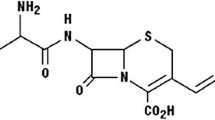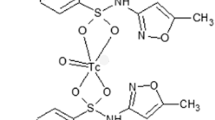Abstract
Purpose
The uptake of 99mTc-UBI (29–41) was evaluated at sites of bacterial infections in rabbits before and after treatment with ciprofloxacin.
Methods
Staphylococcus aureus susceptible to ciprofloxacin was used to induce a focal infection in each rabbit of group 1 (G1), group 2 (G2), and group 3 (G3) with 2 × 104, 2 × 106, and 2 × 108 colony forming units (CFU), respectively. After 24 h, images of infected thighs (target: T) and contralateral thighs (nontarget: NT) were acquired. Animals then received ciprofloxacin intramuscularly for 5 days followed by imaging on the third and fifth days. The control group 4 (G4) was imaged at days 1, 3, and 5 under the same acquisition parameters. Group 5 (G5) was employed to study biodistribution of the peptide.
Results
Increases in (T/NT) ratios in G1, G2, and G3 were observed from 5 min onwards with maximum values at 60 min. G3 revealed the highest accumulation of the peptide. Growth of the same strain of S. aureus on blood agar medium was visualized after fine needle aspiration. After ciprofloxacin treatment, the images for G1–G3 resulted in significantly decreased (P < 0.05) T/NT values on the third and fifth days that correlated with reduction in number of viable bacteria. No significant difference (P < 0.05) in left to right thigh ratios in the control group (G4) was observed. Biodistribution of the peptide showed rapid removal of tracer from circulation through the kidneys.
Conclusions
99m Tc-UBI (29–41) accumulation directly correlates with the number of viable bacteria. This infection localization agent can be utilized for monitoring efficacy and duration of antibiotic treatment.




Similar content being viewed by others
References
Becker W, Meller J. The role of nuclear medicine in infection and inflammation. Lancet Infect Dis. 2001;1:326–33.
Love C, Palestro CJ. Radionuclide imaging of infection. J Nucl Med Technol. 2004;32:47–57.
Filippi L, Schillaci O. Usefulness of hybrid SPECT/CT in 99m Tc-HMPAO-labeled leukocyte scintigraphy for bone and joint infections. J Nucl Med. 2006;47:1908–13.
Bar-Shalom R, Yefremov N, Guralmik L, Kerdar Z, Engel A, Nitecki S, Israel O. SPECT/CT using 67 Ga and 111 In-labeled leukocyte scintigraphy for diagnosis of infection. J Nucl Med. 2006;47:587–94.
Dumarey N, Egrise D, Blocklet D, et al. Imaging Infection with 18 F-FDG-labeled leukocyte PET/CT: initial experience in 21 patients. J Nucl Med. 2006;47:625–32.
Das SS, Hall AV, Wareham DW, Britton KE. Infection imaging with radiopharmaceuticals in the 21st century. Braz Arch Biol Technol. 2002;45:25–37.
Fournier B, Zhao X, Lu T, Drlica K, Hooper DC. Selective targeting of topoisomerase IV and DNA gyrase in Stphylococcus aureus: different patterns of quinolone-induced inhibition of DNA Synthesis. Antimicrob Agents Chemother. 2000;44:2160–5.
Yapar Z, Kibar M, Yapar AF, Togrul E, Kayaselcuk U, Sarpel Y. The efficacy of technetium-99m ciprofloxacin (Infection) in suspected orthopaedic infection: a comparison with sequential bone/gallium imaging. Eur J Nucl Med. 2001;28:822–30.
Sonmezoglu K, Sonmezoglu M, Halac M, et al. Usefulness of 99m Tc-ciprofloxacin (infection) scan in the diagnosis of chronic orthopedic infections; comparative study with 99m Tc-HMPAO leukocyte scintigraphy. J Nucl Med. 2001;42:567–74.
Larikka MJ, Ahonen AK, Niemela O, et al. 99m Tc-ciproflaxacin (infection) imaging in the diagnosis of knee prosthesis infections. Nucl Med Commun. 2002;23:167–70.
Sarda L, Cremieux AC, Lebellec Y, Meulemans A, et al. Inability of 99m Tc-ciprofloxacin scintigraphy to discriminate between septic and sterile osteoarticular diseases. J Nucl Med. 2003;44:920–6.
Appelboom T, Emery P, Tant L, Dumarey N, Schoutens A. Evaluation of technetium-99m-ciprofloxacin (infection) for detecting sites of inflammation in arthritis. Rheumatology. 2003;42:1179–82.
Jones ME, Boenink NM, Verhoef J, Kohrer K, Schmitz FJ. Multiple mutations conferring ciprofloxacin resistance in staphylococcus aureus demonstrate long-term stability in an antibiotic-free environment. J Antimicrob Chemother. 2000;45:353–6.
Akhtar MS, Iqbal J, Khan MA, et al. 99m Tc-labeled antimicrobial peptide ubiquicidin (29–41) accumulations less in Escherichia coli infection than in Staphylococcus aureus infection. J Nucl Med. 2004;45:849–56.
Lupetti A, Welling MM, Pauwels EKJ, Niberring PH. Radiolabeled antimicrobial peptides for infection detection. Lancet Infect Dis. 2003;3:223–9.
Nibbering PH, Welling MM, Paulusma-Annema A, Van den Barselaar MT, Pauwels EKJ. Monitoring the efficacy of antibacterial treatments of infections with 99m Tc-labeled antimicrobial peptides [abstract]. Nucl Med Commun. 2000;21:575–6.
Akhtar MS, Qaisar A, Irfanullah J, et al. Antimicrobial peptide 99m Tc-ubiquicidin 29–41 as human infection-imaging agent: clinical trial. J Nucl Med. 2005;46:567–73.
Nibbering PH, Welling MM, Paulusma-Annema A, Brouwer CPJM, Lupetti A, Pauwels EKJ. 99m Tc-labeled UBI 29–41 peptide for monitoring the efficacy of antimicrobial agents in mice infected with staphylococcus aureus. J Nucl Med. 2004;45:321–6.
Hugo WB, Russel AD, Hodges NA, Danyer S, et al. Laboratory evaluation of antimicrobial agents. Huge and Russel’s pharmaceutical microbiology. 7th ed. Oxford: Blackwell; 2004. p. 199–201.
Duncan DB. Multiple range and multiple F test. Biometrics. 1995;11:1–42.
Ferro-Flores G, Murphy CA, Pedraza-Lopez M, et al. In vitro and in vivo assessment of 99m Tc-UBI specificity for bacteria. Nucl Med Biol. 2003;30:605–15.
Acknowledgments
The authors are thankful to Dr. M. M. Welling, Scientist, Pre-clinical Research Molecular Imaging, Leiden University Medical Center, Leiden, The Netherlands, for his academic discussions and cooperation. In addition, we are indebted to all the staff of Punjab Institute of Nuclear Medicine (PINUM), particularly Mr. Muhammad Yousuf and Mr. Athar Hussain Khan. Dr. Ghulam Muhammad and Dr. Muhammad Saqib of Department of Clinical Medicine and Surgery, University of Agriculture, Faisalabad, need special mentioning for their extended cooperation in the provision of rabbits and their housing, the provision of animal ciprofloxacin, and expertise in animal injections. Mr. Muhammad Ishtiaq of the radioimmunoassay section of PINUM helped in the write up.
Author information
Authors and Affiliations
Corresponding author
Additional information
This study was conducted at Punjab Institute of Nuclear Medicine (PINUM), Faisalabad, in collaboration with the Isotope Production Division (IPD) of the Pakistan Institute of Nuclear Science and Technology (PINSTECH), Islamabad, Pakistan, and the Clinical Medicine & Surgery Department of the University of Agriculture, Faisalabad, Pakistan. There was no sponsor for this research activity. Dr. Muhammad Saeed Akhtar, the first author of this article, is a Ph.D. (Nuclear Medicine) fellow at the Pakistan Institute of Engineering and Applied Sciences (PIEAS) University, Islamabad, Pakistan.
Rights and permissions
About this article
Cite this article
Akhtar, M.S., Khan, M.E., Khan, B. et al. An imaging analysis of 99mTc-UBI (29–41) uptake in S. aureus infected thighs of rabbits on ciprofloxacin treatment. Eur J Nucl Med Mol Imaging 35, 1056–1064 (2008). https://doi.org/10.1007/s00259-007-0671-3
Received:
Accepted:
Published:
Issue Date:
DOI: https://doi.org/10.1007/s00259-007-0671-3




